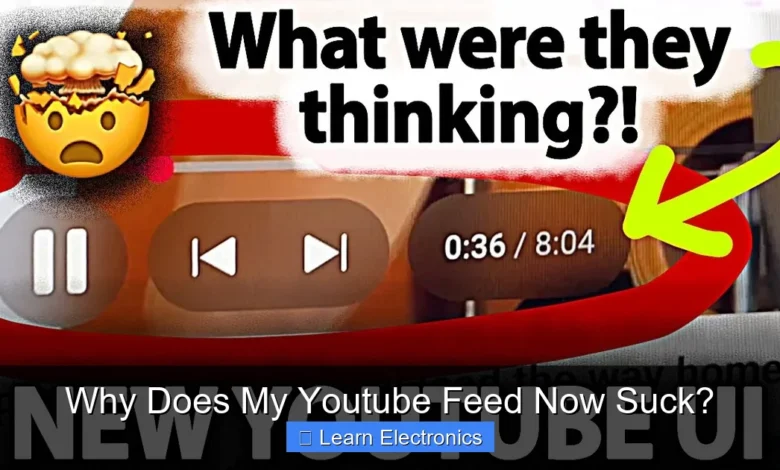Why Does My Youtube Feed Now Suck?

Why Does My YouTube Feed Now Suck? The primary reason is a complex interplay of YouTube’s evolving recommendation algorithms, which increasingly prioritize watch time, short-form content, and advertiser-friendly material over genuine user interest and content diversity. This shift often leads to a stagnant, repetitive, and uninspiring personalized experience for many viewers.
Fundamentally, this approach, while aiming to keep users on the platform longer, paradoxically alienates those seeking fresh, high-quality, or specific niche content. The current recommendations often fall short, pushing viral trends or content you’ve already dismissed.
Quick Answers to Common Questions
Why am I suddenly seeing so much irrelevant content on my YouTube feed?
YouTube’s algorithm is constantly evolving, often prioritizing engagement metrics like watch time and clicks over your direct subscription preferences, which can make your **YouTube feed** feel less personalized and more like a grab-bag of popular (or simply strange) videos.
Did YouTube make a specific change that caused my feed to suck?
While there wasn’t one single “bad update,” the algorithm continually tweaks how it recommends content. This often leads to a shift where popular or trending videos get pushed more aggressively, making your personalized **YouTube feed** feel less relevant to your actual interests.
Is there anything I can do to make my YouTube feed better again?
Absolutely! Actively engaging with content you like (liking, commenting, subscribing) and consistently selecting “Not interested” or “Don’t recommend channel” on videos you dislike can help retrain the algorithm and improve your **YouTube feed** over time.
📑 Table of Contents
The Evolving Algorithm and Its Impact
YouTube’s recommendation algorithm is a constantly shifting beast, designed to optimize for specific metrics. Historically, it aimed for user satisfaction and engagement. More recently, however, the focus has broadened, or some might argue, narrowed, to maximizing watch time and promoting new content formats like YouTube Shorts. This evolution has profound implications for the kind of videos you see.
The Pursuit of Watch Time Over Relevance
In its quest to keep eyes on screens, the algorithm often prioritizes videos that promise longer viewing sessions, even if they aren’t directly aligned with your true interests. This can mean a flood of compilation videos, lengthy explainers on topics you only briefly touched upon, or even sensational content designed purely to grab attention. The nuance of your viewing habits can be lost in this broad stroke, leading to recommendations that feel ‘off’. What started as a highly sophisticated system for personalized content delivery has, for many, become a source of frustration due to this pursuit.
Introduction of Shorts and its Effect
The advent of YouTube Shorts, the platform’s answer to TikTok, has significantly altered the recommendation landscape. Shorts are designed for quick, ephemeral consumption, and the algorithm often pushes them aggressively. If you’ve watched a few Shorts, even casually, your main feed might start to be inundated with similar short-form content, overshadowing the longer, more in-depth videos you might prefer. This integration of distinct content types into a single recommendation system can dilute the quality of personalized suggestions for those who don’t engage heavily with both.
Personalization Paradox: Too Much of a Good Thing?
While personalization sounds ideal, YouTube’s implementation can sometimes lead to a paradox where the feed becomes too specialized, isolating users in content bubbles. The system learns what you like, but sometimes it learns *too well*, preventing discovery and making your experience feel stale.
The Echo Chamber Effect
The algorithm’s intense focus on what you’ve previously watched or engaged with can create an echo chamber. If you watch a particular creator or type of content frequently, the system will relentlessly recommend more of the same. While this is good for consistency, it stifles serendipitous discovery. You might miss out on excellent channels or diverse perspectives because the algorithm believes it knows precisely what you want, even if you’re craving variety.
Stagnation of Content Discovery
For many, the feed’s quality has deteriorated because it ceases to introduce genuinely new or different content. You might see the same few creators repeated, or slight variations on themes you’ve already explored. This stagnation is a common complaint, as users lose the sense of exploration and surprise that once made YouTube an exciting platform. The process of finding fresh voices or learning about new topics becomes a manual chore rather than an algorithmic delight.
The Rise of Clickbait and Low-Effort Content
Another significant factor contributing to a less satisfying YouTube experience is the algorithm’s susceptibility to content designed to game its metrics. This often translates into a surge of clickbait titles, misleading thumbnails, and content that prioritizes virality over substance.
Gaming the Recommendation System
Creators, understandably, want their videos to be seen. This creates an incentive to produce content that the algorithm favors. This often means optimizing titles and thumbnails for clicks (clickbait), structuring videos to maximize watch time (even if the content is stretched thin), and following trending topics regardless of genuine interest. When the system rewards these tactics, your feed inevitably fills with such content, pushing genuinely informative or creative videos further down.
Impact on Creator Incentives
This algorithmic preference also impacts creators. Those who produce high-quality, niche, or long-form content might struggle to gain visibility against viral trends or short-form bursts. This can lead to a shift in creator focus, pushing even established channels towards more algorithmic-friendly formats, further contributing to the perceived decline in feed quality for viewers seeking substance.
User Habits and Feedback Loops
It’s not entirely YouTube’s algorithm; our own viewing habits and interactions also play a crucial role in shaping what we see. Every click, like, dislike, share, and “not interested” signal helps train the algorithm, for better or worse.
Actively Shaping Your Feed
Many users passively consume content without actively giving feedback. If you frequently click on videos with sensational titles, even out of curiosity, the algorithm will assume you like that type of content. Similarly, if you rarely use the “don’t recommend channel” or “not interested” options, the system has fewer explicit negative signals to work with. Your daily practice of interacting with videos is continuously teaching the algorithm, whether you realize it or not.
The Power of “Not Interested”
Utilizing YouTube’s feedback tools is more powerful than many realize. The “three dots” menu next to every video recommendation offers options like “Not interested,” “Don’t recommend channel,” and “Report.” Consistently using these features for unwanted content can gradually refine your feed. While it might take time, this technique is one of the most direct ways to tell YouTube what you *don’t* want to see, helping to clean up unwanted recommendations.
External Factors and Platform Changes
Beyond the core algorithm, other factors like advertising pressures, platform monetization strategies, and even content moderation policies can subtly influence the overall quality and feel of your YouTube feed.
Advertising and Monetization Pressures
YouTube is a business, and advertising revenue is its lifeblood. This inherently means the platform will prioritize content that is advertiser-friendly and capable of generating ad impressions. Sometimes, this can lead to certain types of content being favored or suppressed, subtly altering the diversity of recommendations. The push for premium subscriptions also means features or experiences might be designed to encourage paid access, potentially impacting the free user experience.
Content Moderation Challenges
Dealing with a colossal volume of user-generated content, YouTube faces immense moderation challenges. This can lead to legitimate content being mistakenly demonetized or removed, while other less desirable content might slip through the cracks, impacting the overall reliability and quality of available videos and, by extension, what gets recommended.
Reclaiming Your YouTube Experience: A Guide to Improvement
Even with the algorithmic shifts, you’re not powerless. There are several proactive steps you can take to significantly improve the quality and relevance of your YouTube feed. Understanding the platform’s mechanics and providing deliberate feedback can help you regain control over your viewing experience.
Curating Your Subscriptions
One of the simplest yet most effective strategies is to actively manage your subscriptions. Unsubscribe from channels you no longer watch or whose content quality has declined. Consider organizing your subscriptions into custom collections or using external tools if you follow a large number of creators. A clean subscription list ensures that your “Subscriptions” tab remains a reliable source of content you genuinely enjoy, rather than a cluttered mess that feeds into a mediocre overall algorithm.
Utilizing Feedback Tools Effectively
As mentioned, the “three dots” menu is your best friend. Make it a habit to use “Not interested” on videos that miss the mark and “Don’t recommend channel” for entire channels you wish to avoid. Be patient; these signals take time to propagate through the algorithm, but consistent use will yield results. Liking and disliking videos, and leaving thoughtful comments, also provides valuable, specific feedback that can fine-tune your recommendations.
Exploring New Content Manually
Don’t rely solely on the algorithm for discovery. Actively search for new topics, use the “Explore” tab, or check out external recommendations from blogs, social media, or friends. When you find new channels, subscribe and watch a few of their videos to signal your interest to YouTube. This manual intervention is crucial for breaking out of potential echo chambers and introducing novel data points into your viewing history.
When Your YouTube Feed Now Sucks, Take Action!
It’s easy to get frustrated, but passive consumption only reinforces the current state. If your YouTube feed now sucks, it’s a clear call to action. Dedicate a bit of time each week to clean up your watch history, delete irrelevant searches, and provide negative feedback on unwanted videos. The more effort you put into training the algorithm, the more it will learn to cater to your actual preferences, transforming a frustrating experience back into an enjoyable one.
| Characteristic | Past (Pre-2020) | Present (Post-2020) |
|---|---|---|
| Discovery Focus | Balanced (new & relevant) | Heavy on trending/viral/Shorts |
| Content Diversity | Broader range of topics/creators | Narrower, echo-chamber tendency |
| Recommendation Quality | Often precise and satisfying | Variable, often repetitive or irrelevant |
| User Control | Less explicit feedback needed | More active feedback required |
| Algorithm Goal | User satisfaction, engagement | Max watch time, Shorts promotion |
In conclusion, the decline in the quality of your YouTube feed isn’t just bad luck; it’s a direct consequence of shifts in algorithmic priorities, coupled with how we, as users, interact with the platform. While YouTube continually refines its system, the current iteration often prioritizes metrics like watch time and short-form content over nuanced personal relevance and genuine discovery. However, by understanding these underlying mechanisms and actively engaging with the feedback tools provided, you possess a significant degree of power to curate a more enjoyable and relevant viewing experience. Taking a proactive approach to managing your subscriptions, history, and feedback signals can transform your feed from a source of frustration into the personalized content hub it’s meant to be.
Frequently Asked Questions
Why does my YouTube feed seem so irrelevant lately?
YouTube’s algorithm is constantly evolving, often prioritizing watch time and engagement metrics which might not always align with your personal preferences. This can lead to a wider array of content being shown, some of which may feel irrelevant or repetitive as the system tries to find new things to keep you on the platform.
What caused my YouTube feed to change so much recently?
Recent updates to YouTube’s recommendation algorithm are a primary cause, as the system continually refines how it predicts what you’ll watch next. It might also be influenced by your recent viewing habits, even a few outlier videos, or a broader platform shift towards trending content over personalized deep dives.
How can I improve my YouTube feed and make it better?
You can actively train your YouTube feed by using the ‘Not interested’ or ‘Don’t recommend channel’ options more frequently. Subscribing to channels you genuinely enjoy, watching videos to completion, and engaging with content through likes and comments also sends strong signals to the algorithm about your preferences.
Am I seeing more ads or sponsored content because my YouTube feed sucks?
While your YouTube feed’s perceived decline in quality might be frustrating, the increase in ads is generally a separate monetization strategy by YouTube. Ad frequency and placement are driven by advertiser demand and YouTube’s revenue goals, rather than directly by the quality of your organic recommendations.



